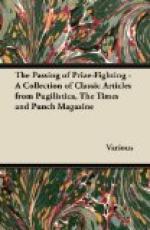Between them Pal and Marigold do all the work. There is room for an epigram if you happen to have one about you, or even an ode, but they can get along without outside contributions. Enid does most of the writing and Hannah copies it out.
So much for prelude to the story of Enid’s serial. Having observed that all the most popular periodicals have serial stories she decided that she must write one too. It was called “The Prairie Lily,” and begun splendidly. I give the list of characters at the head of the first instalment:—
The Duke of Week, an angry father and member of the House of Lords.
The Duchess of Week, his wife, once famous for her beauty.
Lady Lily, their daughter, aged nineteen and very lovely.
Mr. Ploot, an American millionaire who loves the Lady Lily.
Lord Eustace Vavasour, the Lady Lily’s cousin, who loves her.
Jack Crawley, a young farmer and the one that the Lady Lily loves.
Fanny Starlight, a poor relation and the Lady Lily’s very closest friend.
Webb, the Lady Lily’s maid.
Such were the characters when the story began, and at the end of the first instalment the author, with very great ingenuity—or perhaps with only a light-hearted disregard of probability—got the whole bunch of them on a liner going to America. The last sentence described the vessel gliding away from the dock, with the characters leaning over the side waving good-bye. Even Jack Crawley, the young farmer, was there; but he was not waving with the others, because he did not want anyone to know that he knew the Lady Lily, or was on board at all. Lord Eustace was on one side of the Lady Lily as she waved, and Mr. Ploot on the other, and they were, of course, consumed with jealousy of each other.
Having read the first instalment, with the author’s eye fixed embarrassingly upon me, and the author giggling as she watched, I said that it was very interesting; as indeed it was. I went on to ask what part of America they were all going to, and how it would end, and so on; and Enid sketched the probable course of events, which included a duel for Lord Eustace and Mr. Ploot (who turned out to be not a millionaire at all, but a gentleman thief) and a very exciting time for the Lady Lily on a ranche in Texas, whither she had followed Jack Crawley, who was to become famous throughout the States as “The Cowboy King.” I forget about the Duke and Duchess, but a lover was to be found on the ranche for Fanny Starlight; and Red Indians were to carry off Webb, who was to be rescued by the Cowboy King; and so on. There were, in short, signs that Enid had not only read the feuilletons in the picture papers but had been to the Movies too. But no matter what had influenced her, the story promised well.
Judge then my surprise when on opening the next number of The Attic Salt-Cellar I found that the instalment of the serial consisted only of the following:—




